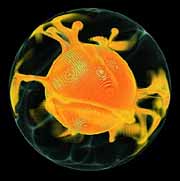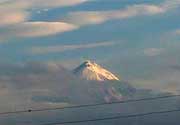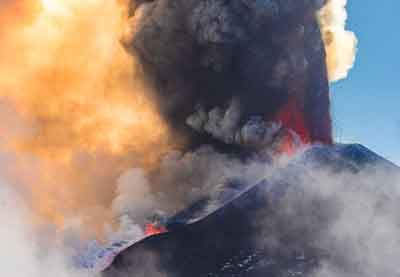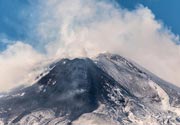A third tectonic setting where volcanism occurs is called intraplate- or hot-spot-volcanism, which describes volcanic activity that occurs within tectonic plates and is generally NOT related to plate boundaries and plate movements.
Most volcanic activity occurs at plate boundaries, but there are also a large number of volcanoes located with a plate, some of which are exceptionally active. These areas of so-called intraplate volcanism are called hot spots.
What causes hot spot volcanism ?
According to the still prevailing theory, most if not all hotspots are believed to be the result of mantle plumes - bodies of warmer, and thus lighter, material within the mantle that rises by convection. It is imagined that these plumes rise as a plastically deforming mass that has a bulbous plume head fed by a long, narrow plume tail.
As the head impinges on the base of the lithosphere, it spreads outward into a mushroom shape. Such plume heads are thought to have diameters between ~500 to ~1000 km
As the plume rises, pressure drops, while the temperature stays high. This causes decompressional melting of the hot mantle material, i.e. the generation of large volumes of magma. It is thought that the massive flood basalt provinces on earth are produced when large mantle plumes reach the lithosphere.
Many scientists believe that mantle plumes may be derived from near the core-mantle boundary, as demonstrated in this computer simulation from the Minnesota supercomputing lab. Note the bulbous plume heads, the narrow plume tails, and the flattened plume heads as they impinge on the outer sphere representing the base of the lithosphere.
(
from: How Volcanoes Work)
Hot spot tracks
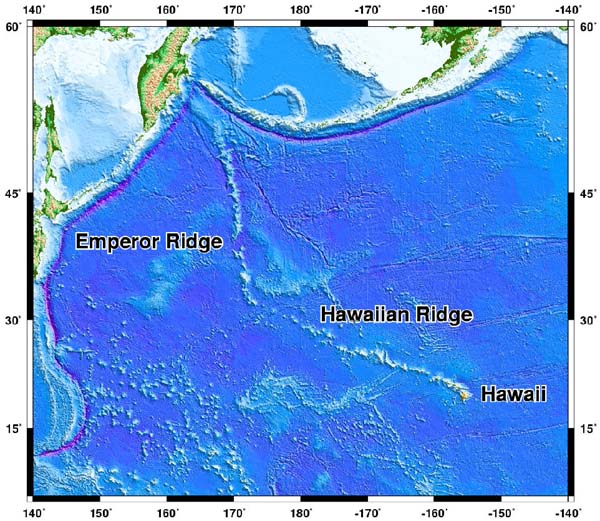
The Hawaiian and Emperor seamount chains. The Hawaiian chain begins at the Hawaiian Islands, to the SE, and continues to the bend located ~5000 km to the NW. From the bend, the Emperor chain continues to the NNW until it terminates at the Aleutian trench (Courtesy of NOAA).
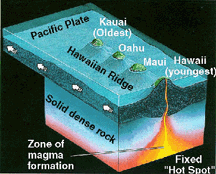
Illustration how the progressively older islands formed above the stationary mantle plume (Courtesy of the USGS).
Mantle plumes appear to be largely unaffected by plate motions. While a plume that feeds hot spot volcanoes remains stationary relative to the mantle, the plate above it usually moves. The result is that a chain of progressively older volcanoes are created on the overlying plate. The best examples of such "
hot spot tracks" are found in the Pacific Ocean.
The Pacific plate contains several linear belts of extinct submarine volcanoes, called seamounts. The formation of at least some of these intraplate seamount chains can be attributed to volcanism above a mantle hotspot to form a linear, age-progressive hotspot track.
As the Pacific plate move across stationary hotspots, volcanism will generate volcanoes (either as active submarine seamounts or volcanic islands) that only are active as long as they are above the mantle plume. As the plate moves them away from their source, their magma supply is eventually cut off and they become extinct, while new volcanoes are formed above the hot spot. Thus, a linear chain of seamounts and island volcanoes is formed.
When an individual volcano has moved away from the source, erosion and sinking caused by its own weight take over and most islands become seamounts again with time. The Hawaiian and Emperor seamount chains are the classic example.
